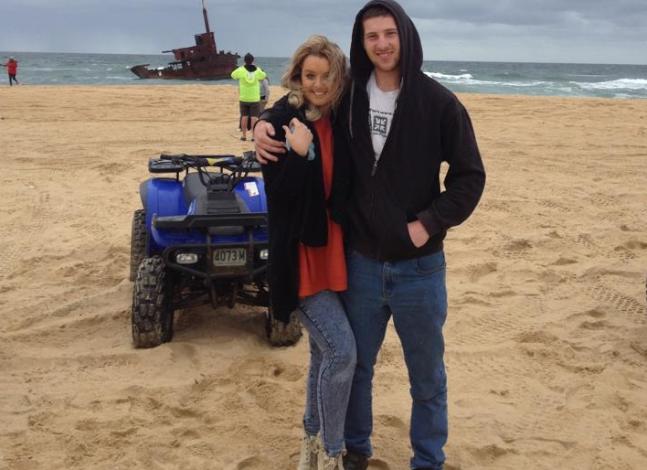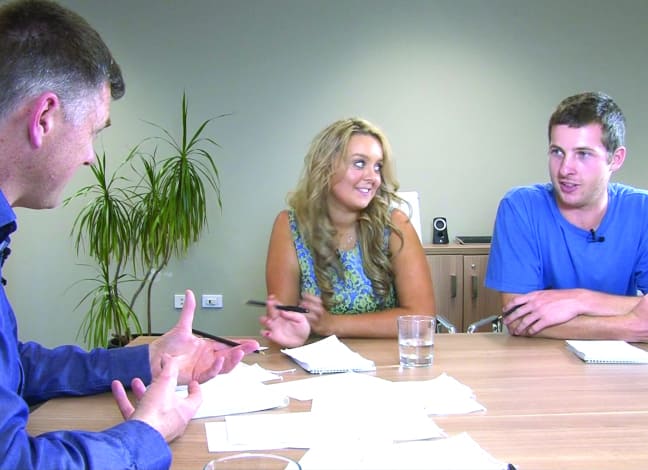Locked and loaded: Phoebe and Carl part 2
Phoebe and Carl are looking to invest in property, but they have no idea where to start. They don’t know how much they can borrow and they’re not sure where to buy – but they do know that simply buying property isn’t enough to guarantee wealth and success.
To continue reading the rest of this article, please log in.
Create free account to get unlimited news articles and more!
Smart Property Investment organised for the couple to sit down with Brendan Kelly from RESULTS Mentoring to crunch the numbers and determine which strategy will help them meet their goals.
Passive income
Mr Kelly says too often investors just jump in and start buying before actually working out what they want to achieve and how they’re going to get there.
Given that Phoebe and Carl haven’t bought their first property yet, Mr Kelly says they are in the perfect position to get things right and avoid the mistakes other, more experienced, investors make.
Mr Kelly and the couple establish that over the next 10 years, they’d like to build up $1.25 million, which they can then use to continue investing in property. They are ultimately aiming for a $100,000 passive income per annum.
“We then need to work backwards from that goal to figure out what we need to be doing this year,” Mr Kelly says. “And that then gives us the scope for how hard we need to go this year in order to achieve that 10-year goal.”
Mr Kelly tells the couple not to get intimidated by the $1.25 million dollar figure because they don’t have to generate the same profit each year.
“Things change and you get better. What you don’t know now, you will know in two years’ time, and you’ll know more again in four years’ time. That allows you to be more efficient with your investing and to undertake bigger deals with more profit. So you’re not going to grow at the same rate every year. Just because you’re aiming for $1.25 million over 10 years, doesn’t mean you need to be generating $125,000 this year,” he explains.
Instead, the couple should be aiming for “half-life, third-value”, he says. Once they crunch the numbers, they realise they should generate a $30,000 profit in their first year of investing.

The basics
“There are basically three things that I believe people need to cover before getting into property for the first time,” Mr Kelly tells the couple. “How much time you have, how much skill you can apply and how many dollars you have to play with. If we can satisfy that, it will then help us select the strategy, and then from there we can select the property and the area.”
At first, the couple believe their borrowing capacity will be constrained by their lack of assets, but Mr Kelly is quick to correct them.
“Assets don’t determine your borrowing capacity,” he says. “Borrowing capacity is determined by your ability to pay the debt back – so your income. Banks historically take your gross income and work on the idea that 30 per cent of your gross income is a safe amount to dedicate to mortgage repayments.”
Working on the basis that the couple has an approximate combined income of $115,000 per annum, Mr Kelly establishes they can put $34,500 towards servicing the debt. Using an interest rate of 5.5 per cent, he tells the couple they are theoretically eligible to borrow $620,000 – “That’s a lot more than we expected,” says Phoebe.
With these figures in mind, Mr Kelly says it’s not the couple’s borrowing capacity that will hold them back, instead it’s the money they have to play with – their deposit.
The couple have a lot of expenses coming up, including Carl’s building licence and insurance, so their deposit money is now sitting at about $20,000.
“The maximum amount in today’s environment that you can borrow is around 95 per cent of the property’s value. Keep in mind that, broadly speaking across the country, five per cent of the purchase price is purchase costs. In New South Wales it’s slightly higher,” Mr Kelly says.
“If you went for a 95 per cent lend, you’re going to need a five per cent deposit and five per cent for purchase costs. Therefore your $20,000 now represents about 10 per cent of the buying price, which means at the moment you can afford something that is around the $200,000 mark.”
The couple also decide that with Carl spending a lot of time establishing his construction career, Phoebe has more time to dedicate to the initial stages of their property investment project.
Phoebe will use her research skills to learn more about the market and find areas which fit their strategy and budget, while Carl can use his skills as a tradesman if they ever need to do renovations or property improvements.
The strategy
Mr Kelly says there are three main strategies that could work for the couple: purchasing multiple cash-flow positive properties and relying on strong rental returns to build wealth, long-term buy and hold in growth areas where they will rely on capital growth to extract equity and make more purchases, or ‘buy, add value, sell’.
Given the couple’s skill set, and their long-term goal of gradually building up $1.25 million, Mr Kelly recommends the third option.
“I find ‘buy, add value, sell’ to be the most effective and efficient way to achieve financial independence through property,” he says.
“You buy, add value and sell, get into a bigger deal, buy, add value, sell and keep going because if you sell, you always have increasing deposits because you’re adding your profit to it every time.”
Mr Kelly explains that this strategy also means the couple won’t limit their borrowing capacity because they are releasing their debt each time and generating bigger deposits.
“The idea is you will keep buying, adding value and selling to the point where you reach $1.25 million in cash,” he says. “Then you take that $1.25 million and go and buy income generating properties outright. You will have no debt, therefore you will have cash-flow positive properties. You can then achieve the passive income of $100,000 per annum that you’re after.”
The couple concede that the strategy goes against conventional wisdom and what they’ve heard about how property investing works.
“There is a general perspective in the market that says ‘buy and never sell’,” Mr Kelly says. “The risk about that though is that you are tied to the property – there’s no escape from it if you don’t sell.
“If it’s negatively geared, you’re always paying out. If the market doesn’t improve, it’s even worse. Your borrowing capacity is limited because to get another property you need to generate a deposit from somewhere, which means you’re either working harder and doing more, or you’re waiting for equity growth.
“So buy, add value, sell is probably the most efficient and effective short-term method of creating capital.”

Renovation realities
Mr Kelly talks the couple through how they can add value to their investment properties through renovations, and the three options available to them: cosmetic renovations, structural renovations and subdivisions.
“If you’re looking for a cosmetic renovation, the time requirement on your part is relatively high. It requires you to manage it and be on the ground. The timeframe for one of those projects end-to-end is about six months, settlement to settlement,” he advises.
“Structural renovations are bigger. They require council permits, they require council intervention, they require different ways of making things happen. You need to be mindful of the limitations that can occur through owner-builder structural renovations.
“Subdivisions themselves are not particularly time intensive because you engage a land surveyor and outsource a lot of the work. The two groups of people that make subdivisions work are your land surveyor and the council. You have to make phone calls and make stuff happen. It’s more coordination and less hands on.”
Mr Kelly explains that if the couple are interested in building on the land once it’s subdivided, they have two options: a custom build or a project homes company. Given Carl’s skill set, Mr Kelly steers them away from project home companies and suggests that further down the track, the couple may be able to move into home construction – but it’s not suitable for their first purchase.
Instead, the couple will start with a small purchase and add value through a cosmetic renovation. Mr Kelly says the most important step here is number crunching.
“In order to know what to do and how to make this work, we need to look at the numbers in a cosmetic renovation deal,” he says. “Why? Because if we know what we need as a profit, we know what we need to buy.”
Mr Kelly says they also need to account for time. He says they should allow three months for the renovation, six weeks for the property to be on the market and a six-week settlement period – just to be safe.
For a six-month project, Mr Kelly says the couple will need to budget for holding costs, which will be about four per cent of the purchase price. He says their budget for the renovation should be about 10 per cent of the property’s purchase price.
“You need a profit amount that’s going to make the project justifiable,” he explains. “Someone needs to be motivated to pay significantly more to buy the property than you paid.”
He uses an example of a $300,000 property to help the couple understand the numbers.
“If I buy a property for $300,000, there is $15,000 in buying costs, $12,000 in hold costs, $30,000 in the reno and you need $30,000 in profit. Selling costs might be around $13,000. So you would need to be selling that property for at least $400,000.
“You would have to sell it for 33 per cent more than you bought it for. That has to become your line in the sand. If you can find a property that you can sell for 33 per cent more than you bought it for on a renovation budget of 10 per cent of the purchase price in a six-month timeframe, you will walk away with 10 per cent of the buying price in profit,” Mr Kelly says.
“You now have a model. You now have what you need to know to establish if a deal is going to work before you buy it. This mitigates the risk of ‘I don’t know what I’m doing, I don’t know what I’m doing – oops, I’ve got no money left’. This is all about not only preserving the capital, but also about walking away with a bigger bank balance.”
Read more:
Getting started: Phoebe and Carl part 1
Setting your sights: Phoebe and Carl part 3
